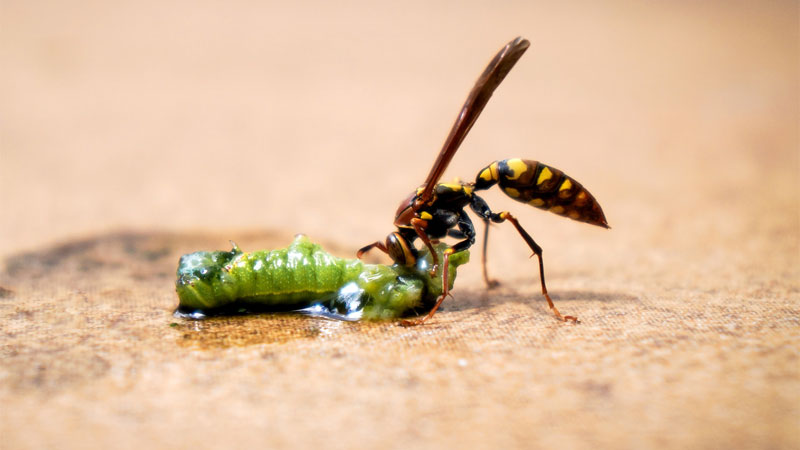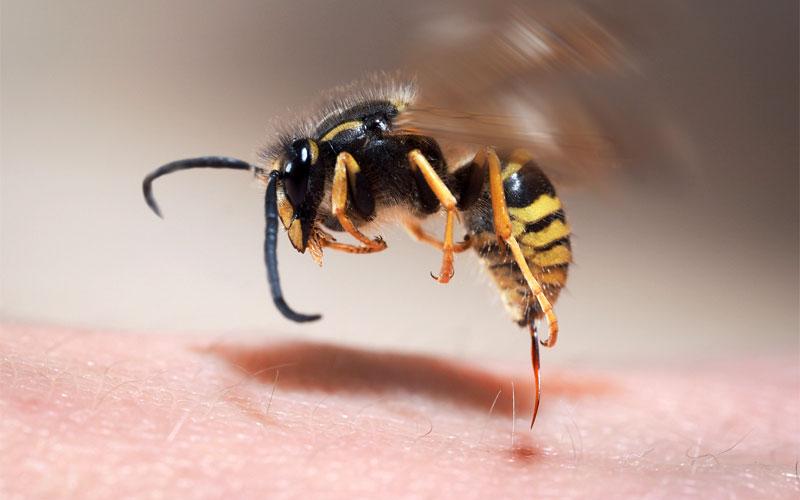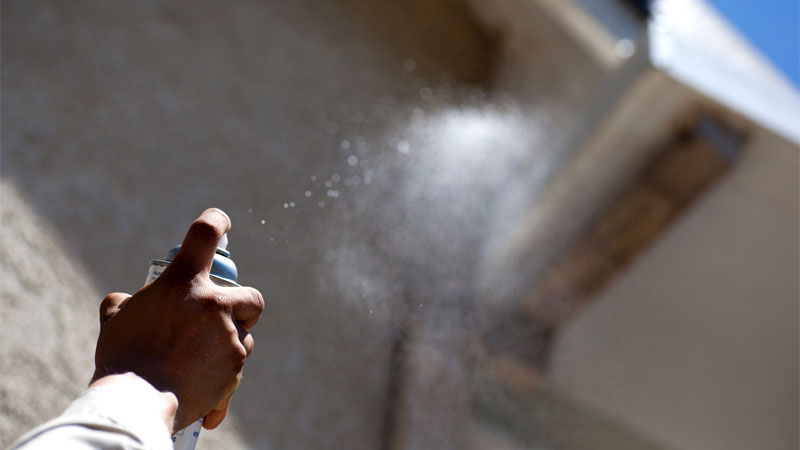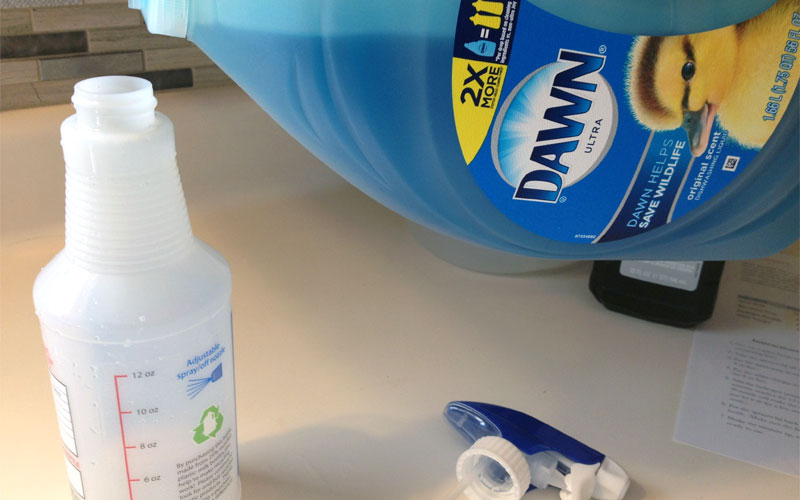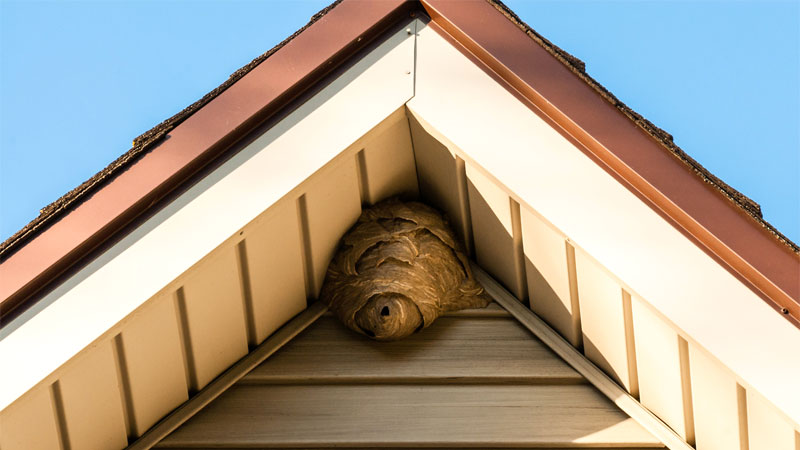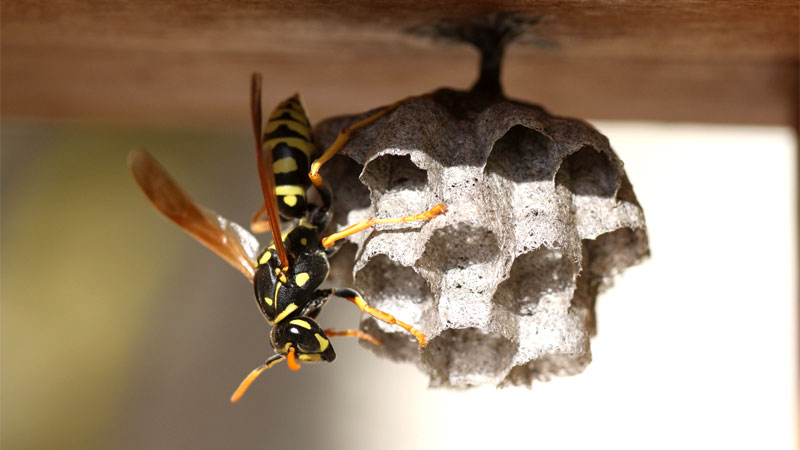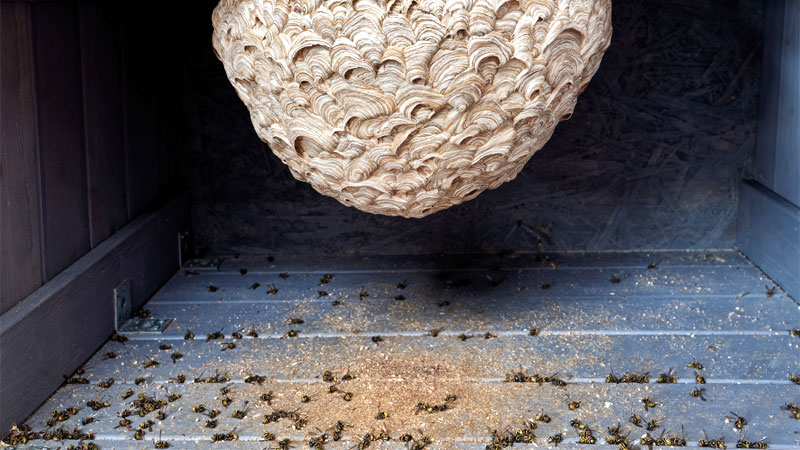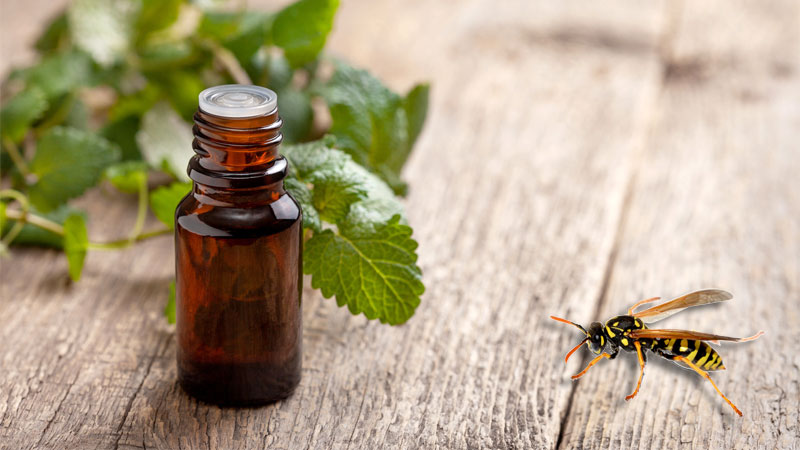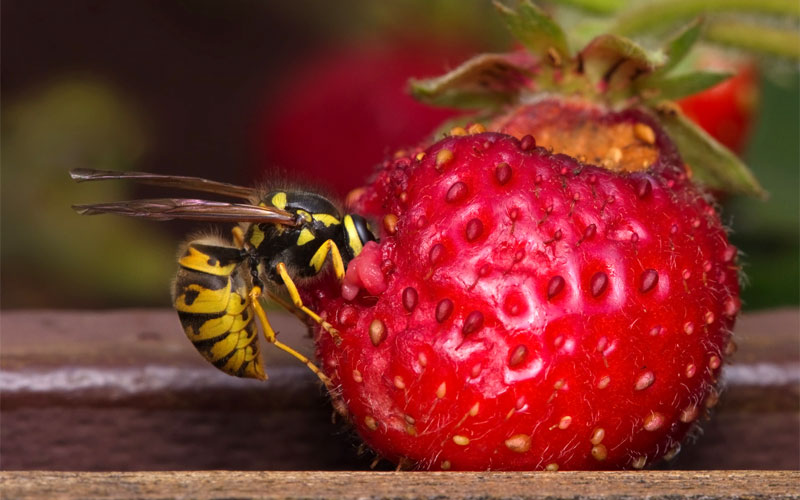Popular throughout the 1980s, parents were usually mortified when they found a WASP infestation in their teenagers’ bedrooms. Unfortunately, more recent generations have only known the smaller, stingier type. But you might be surprised to learn that not all wasps are created equal and it’s not always best to get rid of wasps.
There are thousands of species (currently, the estimate is around 10,000) out there, with as many as 4,000 being either native or introduced to the US. The good news is that most species are relatively easy to get rid of. In fact, some practically apologize as they move on!
So let’s do a quick overview of wasps in general and how to deal with an infestation.
Getting to Know Wasps
Some wasps are beneficial while others are bad news, but the one thing they all have in common is that they can cause an allergic reaction to anyone with a bee allergy and are (usually) not welcome.
Even worse, some wasps resemble other critters, and social wasps tend to be a bigger safety risk than solitary ones.
Types of Wasps
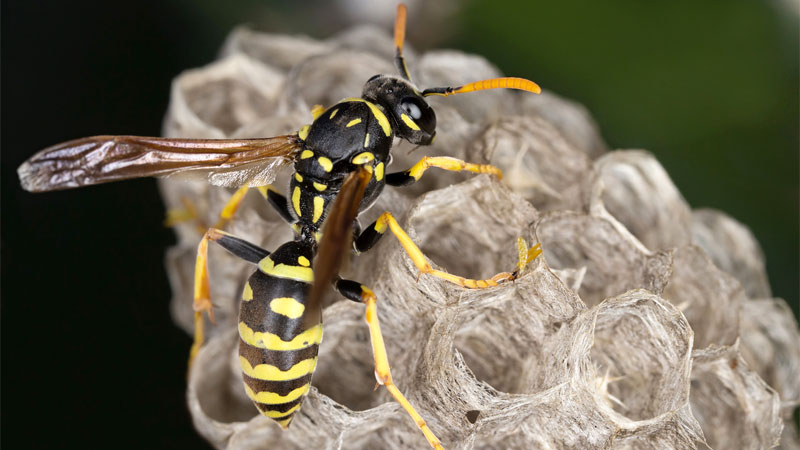
Obviously, this is quite the short list, but these represent the most common kinds of wasps you’ll run into, including a brief description.
#1 – Paper Wasps
These wasps are black or brown with red or yellow markings and have longer legs than other species. They build their nests from regurgitated wood pulp, resulting in a papery substance.
The European paper wasp (Polistes dominula) has a similar appearance to the yellow jacket, but is a valuable asset to the agricultural industry.
#2 – Yellow Jackets
There are 16 different species of yellow jackets in the US, and all are highly aggressive. Most have the characteristic black and gold coloration, although some have white or even red markings.
Despite their hostility, yellow jackets are actually useful pollinators and include both nectar and pest species in their diet.
#3 – Hornets
Hornets are larger than other species of wasp and build colonies that can contain as many as 400 adults. Despite having similar markings to yellow jackets, they tend to be quite docile and will only attack if threatened.
#4 – Mud Daubers
These solitary wasps are thin with yellow markings and a yellow tint to their wings. Unlike most wasp species, mud daubers use mud to make their nests.
#5 – Parasitic Wasps
There are a large number of parasitoid wasp species, all of which look very different
- Cicada killer wasp
- Cow killer wasp (which hunts bumblebees and has a highly venomous sting)
- Four-Toothed Mason Wasp
- Potter wasp
- Spider wasp
- Thread-waisted wasp
- Wood wasp
#6 – Braconid Wasps
With their red bodies and black heads, these tiny wasps closely resemble flies. Their ovipositor is thin and needle-like, allowing them to safely deposit their eggs in trees where few predators will find them.
#7 – Great Black Wasps
These giant wasps have blue-tinted shiny black bodies and will rarely attack humans. Instead, they’re often employed as a predator species and pollinator.
#8 – Cuckoo Wasps
These metallic green wasps aren’t exactly parasitic, although they are squatters. They like to invade the nests of other wasps and lay their eggs.
Of all species, these guys are extremely timid and will curl up and play dead when threatened rather than sting.
#9 – Horntail Wasps
This species is black with brown wings, and the females have a large ovipositor used to inject eggs into tree trunks. However, its generally well-protected larvae are prey to a similar species, the long-tailed giant ichneumonid wasp.
#10 – Blue-Winged Wasps
This black-winged wasp has an orange abdomen and bright yellow spots, making it hard to miss. It’s valued in the agricultural community because it feeds on the Japanese beetle and other pests.
Do Wasps Serve a Purpose?
Many wasp species are actually beneficial. For example, the European paper wasp and parasitic wasp both help eliminate a wide range of major agricultural pests, such as cabbage worms and hornworms.
Meanwhile, other species such as the great black wasp are also pollinators. There are even species that aid in decomposition. In fact, all species serve some benefit to the ecosystem.
Wasp Diet
Parasitic species only tend to feed on pests in the larval stage, so what do the adults eat? Well, some do continue to prey upon pest insects. However, others are attracted to overripe fruit or the remains of sweet foods left on your patio.
They’re also known to snack on pet food, nectar, and even plants, depending upon the species.
Why Are Wasps So Aggressive?
This is actually something of a myth. Yellow jackets and a few other species are, indeed, highly aggressive and even territorial. However, solitary wasps tend to be quite docile unless threatened.
As for the social wasps, it depends on the season of wasp infestation you’re dealing with. In spring and summer, they’ll generally only attack if threatened, but in autumn they’ll usually become more aggressive in an effort to protect the queens on their mating flight.
In general, as long as you don’t bother a wasp, most wasps won’t bother you.
Do Wasps Die When They Sting?
Unlike bees, individual wasps are able to sting multiple times without dying. This can be especially problematic for the more venomous species.
Bees have a barb designed to make removal difficult, which results in the stinger and venom sack being ripped from their body afterwards. Conversely, wasps have smooth stingers which are easily removed. This allows the stinging wasp to jab, withdraw, and jab again in rapid succession.
Wasps vs Bees

As mentioned, one of the key differences between wasps and bees is the shape of the stinger and the ability to sting more than once. Wasps are also generally slimmer than bees.
Bees tend to have hairier bodies, which aids in collecting pollen while wasps are usually glossier in appearance.
Wasps vs Hornets
Contrary to popular belief, hornets are actually wasps. In fact, the hornet genus Vespa contains the largest eusocial wasps out there. Hornets have particularly nasty stings, with venom containing 5 percent acetylcholine.
All hornets are considered to be paper wasps, and closely resemble the yellowjacket in appearance.
Getting Rid of Wasps
We’re going to break this section up a little more than normal because there’s so much to cover. Also, as wasps can be divided into solitary and social, members of these two categories will respond differently to many methods.
Thus, for our usual control section, we’re going to focus on (mostly) non-lethal removal and deterrents (best for solitary wasps). Later, we’ll discuss kill methods (for social wasps).
From the Home (and Other Structures)
The last thing you need is a wasp nest in your home or garage, although you’re more likely to see a solitary paper or mud wasp nest than a colony in places people frequent. This fact makes them a little easier to get rid of, although you’ll also need to use some extra caution due to the more enclosed space.
#1 – Get Rid of Entry Points
Any wasp that actually gets inside your home had to have come in from somewhere, so the first step is to search for any possible entry points and seal them.
The most common ones used by this critter are vents, gaps in window or door frames, and holes under your eaves – but they can squeeze through any small hole or crack.
#2 – Use Insecticide Sprays
One good option for taking down wasps is to use a strong insecticide. Make sure the spray contains pyrethrins, which are known to be effective against wasps, and that it lists these critters on the label. Some sprays will allow you to attack from several feet away, and they kill on contact.
Just be warned, it’s best to only use these spays against lone pests or small nests, as a colony is likely to come at you with everything they’ve got. Also, keep in mind that these sprays can be toxic to humans and pets, so use them responsibly.
- Insects killed: kills wasps, hornets and yellow jackets, as well as tent...
- Up to 27 foot jet spray: stand a safe distance from the Nest while treating
- Eliminates the nest: wait at least 24 hours before removing treated nests
Related: Does RAID Stain Walls?
#3 – Use Glue Traps
Placing a Catchmaster glue trap or similar (such as those used on cockroaches or flies) near a solitary wasp’s nest can often be a great way to eliminate them. However, as the wasps tend to take off from their doorway, you might need to get a little sneaky.
Try dripping a tiny bit of peanut bitter or jelly onto the paper – just enough to serve as bait but not enough to give the wasp a safe landing strip.
While it might be possible to use glue traps safely against a large colony, you’re increasing the risk of contact with survivors and may put the colony itself on alert.
The RESCUE! TrapStik is a bit more expensive than standard glue traps but it’s made specifically for many types of wasps and works pretty well.
- Eliminate Wasps – Our exclusive VisiLure technology lures wasps, red wasps,...
- Visual Attractant – The targeted insects are naturally lured to the trap...
- Thoughtful Design – Our unique Glue Guards create a barrier around the sticky...
From the Yard
Chances are, if you have wasps in your yard, they’re part of a larger colony. Please refer to the “How to Kill Wasps” section below for more info.
DIY Methods
Here are two quick and easy ways to deal with a solitary wasp. Just don’t try this on a group of wasps or an entire colony.
#1 – Homemade Wasp Trap
You’ve probably used a similar method against cluster flies and gnats. Simply take an empty soda bottle, cut the top off where it begins to curve inwards, and invert the top, gluing or taping it on.
Pour some soda or another sweet drink (or even add some bits of protein) into the trap and grease up the rim and bowl area with some vegetable oil so the wasps can’t escape once they try to enter. Be sure to stick the trap in a freezer for a few hours before emptying to ensure you don’t get stung by survivors.
#2 – Soapy Water (vs Solitary Wasps)
Adding a few tablespoons of dish soap to a gallon of water can make a cheap and effective form of pest control for a wide range of pest species, but should only be used against isolated wasps.
Simply grab a spray bottle and target the resting wasp. The soap will weigh down their wings and (more importantly) clog their airways, causing them to suffocate on the spot.
Just be warned that attacking where there are multiple wasps can result in the ones you fail to squarely hit coming after you.
Related: Does Soapy Water Kill Wasps?
How to Safely Remove a Wasp Nest
The method for removing a wasp nest can differ depending on the type of wasp you’re dealing with. For example, paper and mud nests can usually be removed with very little effort.
Simply watch for when the wasp leaves its nest, then put on some protective gloves and remove it with a paint scraper. In most cases, the wasp will simply find somewhere else to rebuild when it finds its home gone.
Social wasps are another matter entirely. There are methods all over the internet for removing these nests yourself, but the risk of angering hundreds or even thousands of wasps just isn’t worth the risk.
When you need to deal with a social wasp nest, call in a wasp exterminator. Believe us when we say, professional removal is a lot cheaper than a hospital bill.
See Also: How Much Does a Wasp Exterminator Cost?
How to Kill Wasps
While the following methods can be used against solitary wasps, you’re more likely to be able to simply evict those from your property. But an entire colony is another matter, and it’s strictly kill or be killed when dealing with a social wasp infestation.
When to Kill Wasps
Unlike solitary species, a wasp colony isn’t going to just relocate because you’ve inconvenienced it. Instead, you’re going to have to face the masses in a battle royale – or are you?
No matter what remedies you plan to use, timing is everything if you’re going to attack a colony. Wasps are sluggish at night and most will be inside the nest. This may seem counterproductive, but when you have stinging insects that like to patrol, the less security on duty, the better.
The season is also important. If you can take out a colony in spring when it’s just starting up, you can often handle it on your own. However, that same colony will house thousands of enemies when autumn rolls around. At this point, it’s best to hire pest management to deal with the colony on your behalf.
Winter is perhaps the best season to go on the offensive, as the coolest time of year is also when flying pests are at their least effective.
Using Insecticides
Insecticides come in three basic flavors: baits, powders, and sprays.
- As we’ve mentioned, sprays (Spectracide is good and cheap) are best used on isolated wasps to prevent the risk of retaliation. For enclosed areas, such as a shed or attic, a wasp bomb or fogger works best.
- Baits (like the RESCUE! Trapstik) can be hung from trees and other spots and work the same as your average bait trap. For yellow jackets, a disposable trap is the most common method.
- Powders (like Delta Dust), on the other hand, are best used on ground nests and can be sprinkled around the entrance at night.
Remember, these insecticides can also harm beneficial insects, so use them responsibly.
Home Remedy No-Nos
There are some good DIY methods out there, and then there are some where you’re just begging to be stung. Here are some of the most dangerous suggestions you’ll find on the internet.
Boiling Water
While a great way to kill ant mounds, the idea of pouring boiling water over a wasp nest is just plain crazy. Yes, the water will kill wasps on contact and may even melt the nest, but you’re just asking for trouble. Some sites will claim you’ll be safe if you time the attacks and pour one bucket every few days.
What they don’t tell you is that the moment your bucket of water hits the nest, hundreds of angry wasps will go on high alert and begin patrolling for anything that moves, including you.
Fire!
Okay, we’re not sure what maroon came up with this idea, but it’s as dangerous as it is idiotic. No doubt someone was on their fifth beer and came to the conclusion that if beekeepers can control bees with smoke, using actual fire on a wasp nest must be even more effective. It’s not.
Instead, setting a wasp nest on fire will induce flashbacks of the Pacific Rim with dozens or more frenzied fireballs going kamikaze on you as they burn. In other words, wasps plus fire equals a war you can’t win.
Soapy Water (vs Colonies)
Yet another home remedy based on tactics that work on other critters, soapy water in a spray bottle might be able to suffocate one wasp while they’re resting on a surface, but some like to go a step further and recommend you take bucket loads of soapy water to the colony itself.
As with boiling water, this method will just make the wasps angry and they’ll go on the offensive as soon as the the water hits.
How to Keep Wasps Away
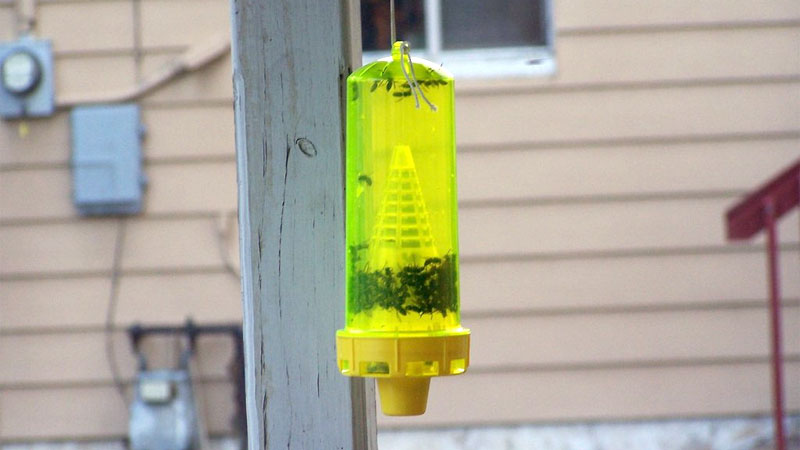
Whether you’ve just gotten rid of an infestation or wish to be proactive, there are a number of ways you can discourage wasps from coming onto your property.
The following methods were picked because they not only work against wasps, but also many other pest species.
#1 – Attract Natural Predators
Orioles, starlings, and other insectivores will actively hunt wasps, making them great to have around. Just be warned that these birds often have their own predators (jays, for example) and can sometimes become pests themselves.
#2 – Exclusion Devices and Entry Points
We’ve already discussed entry points for pests to get inside of structures, but there are also spaces outside of your home that can harbor wasps.
For example, there’s often a crawlspace under your porch or deck, and the space under your eaves are a common nesting point for a number of critters. These spaces should be sealed or otherwise made inhospitable.
You can get fine screens or a similar exclusionary device to put over vents and soffits. Eaves are a bit more difficult to protect, but it’s a good place for a fake wasp nest (which we’ll discuss momentarily).
Seal up any crawl spaces by boarding or bricking them over and sealing the edges. You can also put repellent plants around the porch to keep wasps and other pests away.
#3 – Repellent Plants
That brings us to the next method – companion planting. A number of plants give off scents that are pleasant to humans but horrible for insect pests.
These plants can be placed among the regular plants in your garden or in flower pots to keep many wasp species away (parasitic wasps being a possible exception, depending on the species).
Some popular choices include:
- Alliums (such as garlic and onions)
- Basil
- Citronella
- Cloves
- Eucalyptus
- Geraniums
- Lemongrass
- Marigolds
- Mint (especially peppermint)
- Thyme
#4 – Build a Fake Wasp Nest
Having a family craft hour can be more than just fun, it can be beneficial and even educational. Create a paper maché wasp nest (or simply buy one) and give it a waterproof coating. Some people like to glue dead insects on the nest for added effect.
Hang your fake nest under the eaves, in a tree, or anywhere else real wasps might want to set up shop.
There’s one downside to this trick, however. Some wasps, such as the cuckoo wasp, like to lay their eggs in other nests, so your decoy may have the opposite effect on them.
- 3 PACK (From Maad Brands) - The pack of three allows you to hang the fake wasp...
- REALISTIC SIZE - Once propped open, the hanging deterrent nest measures to be 8...
- INNOVATIVE & SAFE - Wasps are territorial and instinctively, will not build nest...
#5 – Removing Food Sources
This is a great method for keeping most pests away, not just wasps. Keep all of your garbage tightly covered and clean the grill after every use. You’ll also want to use sealable compost bins as opposed to leaving the pile exposed.
Be sure to clean up any food waste or spilled drinks. You should also keep any sugary drinks in a clear cup if you suspect there to be wasps about, as they’ve been known to crawl into soda cans creating the risk that you might accidentally swallow one.
While you’re at it, try to remove any sources of standing water, as these can attract wasps and other insect pests they prey on.
#6 – Keeping Wasps Away From Hummingbird Feeders
Finally, hummingbird feeders can be problematic enough that they deserve specific mention. Nectar-loving wasp species will see these feeders as a prime food source. Thankfully, there are a few things you can do to deter them.
The easiest solution is to keep your hummingbird feeder far from the house, but this can also defeat the purpose of being able to watch these little feathered friends. You can also set up a fake wasp nest nearby to scare off many species.
As for the feeder itself, try investing in one that’s all-red, as yellow will attract wasps. If you need to, you can repaint yellow parts using a non-toxic paint. You can also use a nectar guard or buy a no-insect feeder that makes it harder to reach the nectar from the feeding ports.
- How to Get Rid of Hawks - March 8, 2024
- How to Get Rid of Pill Bugs (Rolly Pollies) - March 1, 2024
- How to Get Rid of Groundhogs (Woodchucks) - February 5, 2024


 Just tell me how to get rid of ’em.
Just tell me how to get rid of ’em.